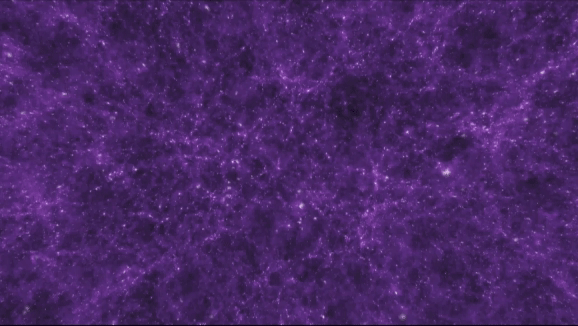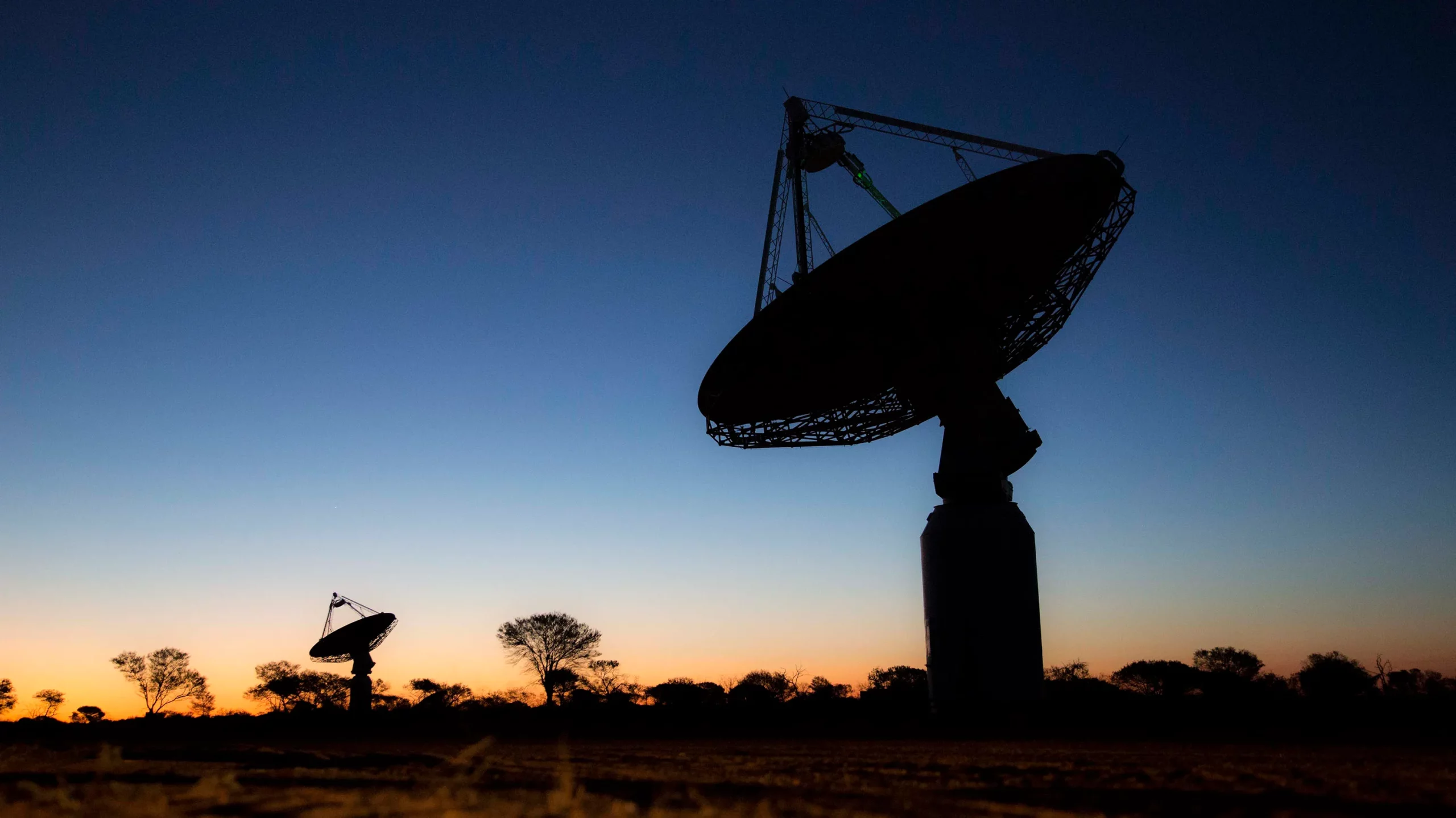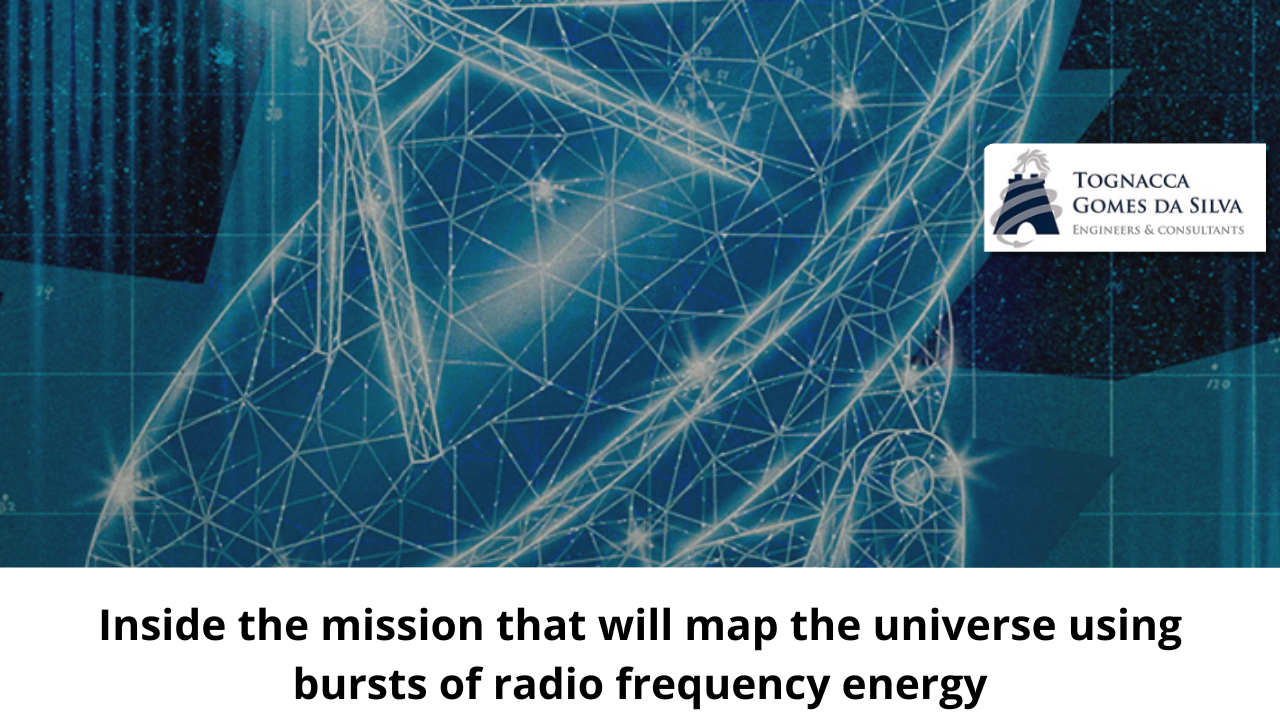When our universe was less than half the age it is today, a sudden burst of energy capable of cooking popcorn equivalent to the mass of a sun was emitted from somewhere in the midst of a compact group of galaxies. About 8 billion years later, radio waves from that explosion reached Earth and were picked up by a sophisticated low-frequency radio telescope in outback Australia.
The signal, detected on June 10, 2022 and lasting less than half a millisecond, is part of a growing group of mysterious radio signals called fast radio bursts (or FRBs). Over the past 10 years, astronomers have detected nearly 5,000 of them. This one, in particular, was special: it was almost twice as old as any previously observed event and had an amount of energy three and a half times greater.
But, like the others that were studied before it, it remained a mystery. No one knows what causes the fast radio bursts. They appear in a seemingly random and unpredictable pattern, coming from everywhere in the sky. Some arise from within our galaxy, others from depths of the universe that have not yet been fully explored. Some repeat in cyclical patterns for several consecutive days and then disappear, while others have shown a consistent repeating pattern, emitting signals at regular intervals every few days since we first identified them. However, most are never repeated.
Despite the mystery, these radio waves are starting to prove incredibly useful for astronomy and understanding the universe. By the time our telescopes detect them, they have already passed through a variety of interstellar media, such as billowing clouds of hot plasma and through gases so diffuse that the particles barely touch, as well as passing through our own Milky Way. And each time they encounter free electrons floating in those locations, their frequency is slightly changed. Those detected by our telescopes carry with them a kind of “fingerprint” of all the common matter with which they interacted throughout their journey through space to where we are now.
This makes FRBs invaluable tools for scientific discovery, especially for astronomers interested in studying the widely dispersed gases and dust that float between galaxies, about which we know very little.
“We don’t know what they are, or what causes them. But it does not matter. This is the tool we would have created and improved upon if we had the chance to step into the role of God and create the universe,” says Stuart Ryder, an astronomer at Macquarie University in Sydney, Australia, and lead author of the Science paper that documented the quick radio burst that reached a historic milestone.
Many astronomers are now confident that finding more distant FRBs will make it possible to create the most detailed three-dimensional cosmological map in history, something Ryder compares to a CT scan of the universe. Just five years ago, making such a map would have seemed a nearly impossible technical challenge: Detecting an FRB and then recording enough data to determine where it came from is extremely difficult because most of this work must occur in the few milliseconds before the radio disappears.
But this challenge is about to be overcome. By the end of this decade, a new generation of radio telescopes and technologies related to this area will begin operations in Australia, Canada, Chile, California and other observatories should turn to the search for FRBs. These technological advances will help scientists unravel the mystery behind fast radio bursts. What was once a series of random discoveries will become almost routine. Not only will astronomers be able to draw up a new map of the universe, but they will also have the chance to significantly improve our understanding of how galaxies are born and how they change over time.
Where is the matter?
In 1998, astronomers calculated the weight of all identified matter in the universe and came up with an intriguing result.
We know that about 5% of the total weight of the universe is made up of baryons, which are subatomic particles such as protons and neutrons that make up atoms, essential for the formation of all common matter in the universe. The other 95% is made up of dark energy and dark matter. But astronomers have only been able to locate about 2.5%, not 5%, of the total matter in the universe.
“They counted stars, black holes, white dwarfs [extremely dense stellar remnants formed after the collapse of low- to intermediate-mass stars], exotic objects, atomic and molecular gas in galaxies, hot plasma, etc. They added it all up and found that the total amount of matter observed was twice as small as it should be,” says Xavier Prochaska, an astrophysicist at the University of California, Santa Cruz, USA, and an expert in analyzing the light emitted since the early stages of the universe.
“It’s embarassing. We are not actively observing half the matter in the universe.” All these baryons that astronomers were unable to detect represent a serious problem for simulations that try to explain several fundamental aspects of astrophysics and cosmology, such as how galaxies form, how our universe is structured and what its future destiny will be. Astronomers began to speculate that the missing matter could exist in extremely diffuse clouds of what is known as the warm-hot intergalactic medium, or WHIM. Theoretically, WHIM would encompass all this unobserved material. After the 1998 article was published, Prochaska dedicated himself to finding it.
However, after almost 10 years of his life had passed and about $50 million in taxpayer money later, the search was going badly.
Her focus had mainly been on unraveling the light emitted from distant galactic nuclei and studying x-ray emissions from filaments of gas that connect galaxies. The breakthrough came in 2007, when Prochaska was reviewing new research articles with his colleagues at the University of California, Santa Cruz, sitting on a couch in a conference room. There, among the piles of research, was the paper reporting the discovery of the first FRB.
Duncan Lorimer and David Narkevic, astronomers at West Virginia University, USA, had discovered a record of an energetic radio wave unlike anything previously observed. The wave lasted less than five milliseconds and its spectral lines were very blurred and distorted, unusual characteristics for a simple radio wave, and an indication that it was brighter and more energetic than other known transient phenomena. The researchers concluded that the wave could not have come from within our galaxy, meaning it had traveled an unknown distance across the universe.
Here they had a signal that had traveled long distances in space, was shaped and affected by electrons along the way, and had enough energy to be easily detected, despite having encountered several interferences along its path. Currently, there are no other known and detectable signals in the entire universe that occur with such regularity and exhibit all of these characteristics.
“I saw this and said, ‘Wow! This is how we can solve the problem of the baryons we can’t find,’” Prochaska said. Astronomers had used a similar technique with light emitted by pulsars (rotating neutron stars that emit radiation from their poles) to count electrons in the Milky Way. But pulsars are too weak to illuminate areas of the universe beyond our galaxy effectively. In this sense, FRBs were thousands of times brighter, providing a way to use this technique to advance our understanding of the entire universe.

However, there is a problem: for an FRB to be a clue to what exists among the empty space of galaxies, researchers have to know its origin. If you don’t know the distance traveled by the FRB, you can’t make any inferences about what exists in the space between the point of origin of that wave and Earth.
Astronomers couldn’t even pinpoint which direction the first FRB of 2007 came from, let alone calculate how far it traveled. It was detected by a huge single-dish radio telescope at the Parkes Observatory (now called Murriyang) in New South Wales, Australia, which is excellent at picking up radio waves arriving at our planet, but it could not provide accurate enough information to determine its location. exact location in the sky, pointing only to an area as large as the full Moon seen from Earth. Over the next ten years, telescopes continued to identify FRBs without being able to provide a precise origin for these events, making them a fascinating mystery but not very useful for practical studies.
Then, in 2015, one particular radio wave appeared. And then it was detected again. Over the course of two months of observation using the Arecibo telescope in Puerto Rico, these radio waves were detected repeatedly, reappearing a total of 10 occasions. This was the first episode of repetitive FRBs ever observed (a mystery in itself), and now researchers had the chance to study them in more detail and determine their origin with greater precision.
In 2017, researchers were able to accurately determine the position of the fast radio burst using the National Radio Astronomy Observatory’s (NRAO) Very Large Array telescope, located in central New Mexico. With this position in hand, researchers used the Gemini optical telescope in Hawaii to take a photo of the location in question. This revealed the galaxy where the FRB had originated and the distance it had traveled. “That’s when it became clear that it would be possible to determine the distance of at least some of these bursts. It was from there that I became really involved in research and started writing study proposals to use other telescopes in research,” says Prochaska.
That same year, astronomers from around the world met in Aspen, Colorado, USA, to discuss the potential of studies on FRBs. Researchers debated what caused them. Neutron stars? Magnetars, that is, neutron stars with magnetic fields so powerful that they emit x-rays and gamma rays? Merging galaxies? Aliens? Did the repetitive and singular FRBs have different origins, or could there be another explanation for why some bursts repeat and most do not? Did it really matter since they could all be used as space probes regardless of what caused them? At this meeting in Aspen, Prochaska met with a team of astronomers studying radio waves and working in Australia, including Keith Bannister, a telescope expert involved in early work to build a precursor facility for the Square Kilometer Array, an international collaboration. which aims to build the largest arrays of radio telescopes in the world.
Construction of this precursor telescope, called ASKAP, was still underway during this encounter. But Bannister, a telescope expert at the Australian government’s scientific research agency CSIRO, believed ASKAP had the potential to contribute significantly to FRBS research and could be adapted to locate and study them.
Bannister and the other radio astronomy experts affiliated with ASKAP understood how to manipulate radio telescopes to meet the specific demands of the search for FRBs, while Prochaska was an expert in the other areas. They agreed to work together to identify and locate singular FRBs (because they are much more common than repeating ones) and then use the data to address the challenge of the discrepancy between the amount of baryonic matter predicted by cosmological models and the amount observed. . And over the next five years, that’s exactly what they did, achieving surprising success.
Building the system
To identify a burst in the sky, you need a telescope with two things that are very difficult to reconcile in radio astronomy equipment: a very wide field of view and high resolution. The wide field of view maximizes the likelihood of detecting an unpredictable, fleeting burst. The high resolution allows us to accurately determine where exactly this burst is located within this observed area.
ASKAP was the perfect device for this. Located in the westernmost part of the Australian Outback, where cattle and sheep graze on public land and there aren’t many people around, the telescope consists of 36 satellite dishes, each with a wide field of view, which increases the chances of detection of FRBs.
These antennas are separated by large distances, allowing interferometry to be carried out, a technique that allows the combination of information collected to create an image of a small region of the sky, thus allowing a detailed investigation of FRBs. The antennas weren’t officially in use yet, but Bannister had an idea. He took them and improvised a “fly’s eye” telescope, pointing the antennas at different parts of the sky to maximize his ability to detect anything that might appear anywhere in space.
“Suddenly, it felt like we were living in paradise,” says Bannister. “Up until this point, there had only been three or four detections of FRBs. People weren’t entirely sure if they were real or not, and we were meeting them every two weeks.”
When the ASKAP interferometer went into operation in September 2018, the work truly began. Bannister developed software that does something similar to a real-time replay of the FRB event. “It’s as if the burst passes by, hits your telescope and disappears, and you have a millisecond to write down its license plate,” he says. To do this, the software detects the presence of an FRB within a hundredth of a second and then accesses the telescope data from that moment to create a record before it is overwritten by the system. Thus, data from all antennas can be processed and combined to reconstruct a complete view of the sky and locate a precise point of origin for the FRB.
The team can then send the coordinates to optical telescopes, which can take detailed photos of the location to confirm the presence of a galaxy, which would be the FRB’s likely point of origin.

These two antennas are part of CSIRO’s ASKAP (Australian Square Kilometer Array Pathfinder) telescope. CSIRO[/caption] Ryder’s team used data on the galaxy’s spectrum, gathered by the European Southern Observatory, to measure how much the light from the studied point “stretched” as it traveled through space until it reached our telescopes. This “redshift”, therefore, becomes a distance indicator, allowing astronomers to estimate exactly how far the FRB moved before reaching Earth.
In 2018, real-time replay worked for the first time, making Bannister, Ryder, Prochaska and the rest of their research team the first to spot an FRB that wasn’t repeating. By the following year, the team had located about five of them. In 2020, they published an article in the journal Nature stating that the study of FRBs had made it possible to estimate the number of undetected baryons in the universe.
The central question of the paper was something called a dispersion measure, a number that reflects how much the light from an FRB was scattered or diffused by all the free electrons it encountered along the way until it reached telescopes on Earth. In general, the further an FRB travels, the greater its dispersion measure should be. Using both the travel distance (the redshift) and the measure of dispersion of various FRBs, the researchers found that they could make estimates about the total density of particles in the universe.
J-P Macquart, the paper’s lead author, believed that the relationship between dispersion measure and FRB distance was predictable and could be applied to map the universe. FRB researchers began calling the relationship between dispersion and distance the “Macquart relationship,” in recognition of his contributions and in honor of his memory and pioneering idea that FRBs could be used to increase our knowledge of the universe. Thus, proving that Macquart’s relationship remains valid even when observing more distant astronomical objects became not only a scientific quest, but also a journey with a strong emotional nature.
“I remember thinking I knew something about the universe that no one else knew.”
Researchers knew that the ASKAP telescope was capable of detecting bursts coming from very far away. It was just a matter of finding one. Whenever the telescope identified an FRB, it was up to Ryder to help determine its origin. This took much longer than he would have liked. But one morning in July 2022, after many months of frustration, Ryder opened the email with the latest data from the European Southern Observatory and began analyzing the spectral data. As he scrolled through the screen, something surprising caught his attention: optical emissions of oxygen coming from the astronomical source he was observing, represented by two very close, bright lines on the computer screen, indicating signs of the presence of light that had traveled 8 billion years until then, or rather, a red shift of one. “I remember thinking I knew something about the universe that no one else knew,” he says. “I wanted to go on Slack and tell everyone, but I thought, no, just sit there and enjoy the moment. It took a long time to reach this result.” The October 2023 paper in the journal Science was an important milestone for the team, as it essentially doubled the distance baseline for the Macquart relationship, honoring the researcher’s memory in the best way they knew how. This increase in the observed distance was crucial because Ryder and the other members of his team wanted to confirm that his work would remain valid even for FRBs whose light came from so far away that they would represent a much younger universe. Furthermore, by confirming the possibility of finding other FRBs at this same redshift, they could collect evidence of a large sample of bursts in a variety of conditions to create the cosmological map, something that greatly stimulates research into they.
“It’s encouraging that the Macquart relationship still seems to make sense, and that we can still see fast radio bursts coming from these greater distances,” Ryder said. “We imagine there are a lot more of these events out there.”
Mapping the cosmic web
We often call the invisible elements that lie between galaxies the cosmic web, something that should contain the majority of matter in the universe. The diffuse gases present in this space are not floating like random clouds, but rather interconnected, as if they were a spider’s web, a complex interweaving of delicate filaments that extend as the galaxies grow and move from their nodes. These gases likely escaped from galaxies during their formation, being pushed out by massive explosions.
“We don’t understand how gas is pushed in and out of galaxies. And this is crucial for understanding how they form and evolve,” says Kiyoshi Masui, director of MIT’s Synoptic Radio Lab. “We only exist because stars exist, and yet this process of developing the foundations of the universe is very poorly understood… Our inability to create theoretical or computational representations of this process is a significant flaw in our understanding of how space works.” .
Astronomers are also building detailed maps of galaxies to precisely measure the expansion of the universe. Furthermore, the cosmological modeling that is underway with studies of FRBs should create a visual representation of the invisible gases between galaxies, something that currently does not exist. To build a three-dimensional map of this cosmic web, astronomers will need precise data on thousands of FRBs from regions near Earth and far away, such as Ryder’s redshift FRB. “Ultimately, the fast radio bursts will allow us to create a very detailed picture of how the gas moves,” says Masui. “To get cosmological data, the number of samples has to be greater, but it doesn’t have to be huge.”
That’s the current task for Masui, who leads a team searching for FRBs that are much closer to our galaxy than those found by the Australian-led research group. Masui’s team conducts searches for FRBs with the CHIME telescope in British Columbia, Canada, an unconventional radio telescope that has a large coverage area and reflector focusers that look like semi-cylindricals rather than antennas. CHIME (short for “Canadian Hydrogen Intensity Mapping Experiment”) has no moving parts and is less dependent on mirrors than a traditional telescope. Instead, it focuses light in just one direction, as opposed to the two directions of conventional models, and employs digital techniques for data processing. CHIME can use its digital technology to focus on many places simultaneously, creating a 200 square degree field of view compared to ASKAP’s 30° field of view. Masui compared it to a mirror that can be focused on thousands of different places at the same time.
Because of this unique feature, CHIME was able to collect data on thousands of bursts that are closest to the Milky Way. Although it cannot precisely locate their origin as well as ASKAP (due to its compact size and therefore lower resolution), Masui is leading an initiative to address this. He is building three smaller versions of the same telescope in British Columbia, Green Bank (in West Virginia, USA) and Northern California. Additional data collected by these telescopes, the first batch of which will likely be collected later this year, can be combined with data from the original CHIME to generate location information with approximately 1,000 times greater accuracy. This should provide enough detail for cosmological mapping.
Telescope technology is improving so rapidly that the mission of collecting enough data from multiple FRB events in various regions of the universe to create a cosmological map could be completed within the next 10 years. In addition to CHIME, the BURSTT radio telescope in Taiwan is expected to come into operation this year; the CHORD telescope in Canada, designed to surpass CHIME, is expected to begin operating in 2025; and the Deep Synoptic Array in California could revolutionize the field of radio astronomy when it is fully operational, an achievement expected to occur approximately at the end of this decade.
And at ASKAP, Bannister is building a new tool that will quintuple the telescope’s sensitivity in detecting signals from FRBs, starting this year.
If you can imagine a million people watching uncompressed YouTube videos simultaneously in a relatively small space, like a refrigerator-sized box, that would probably be the easiest way to understand the data processing capabilities of this new device, called a field-programmable gate array (or FFPGA), which Bannister is almost finished programming. He hopes the new device will allow the team to detect one new FRB per day. With all these telescopes competing, Bannister says, “in five to 10 years, 1,000 new FRBs will be detected before you can write a paper about the one you just found… We’re in a race to make them boring.” Prochaska is so confident that FRBs will finally provide us with the cosmological map he has been seeking all his life that he has begun studying for a degree in oceanography. Once astronomers have measured the distances of 1,000 different bursts, he plans to abandon the area entirely.
“In a decade, we could have a pretty decent and very accurate cosmological map,” he says. “This is why we would measure the distance of the 1,000 FRBs. And if we can’t build that, I should be fired.”
Unlike most scientists, Prochaska is able to outline the ultimate goal of this project. He knows that all these FRBs will allow astronomers to draw a map of the invisible gases in the universe, revealing how galaxies evolve as they move out of them and then return. FRBs will provide us with a more complete understanding of the shape and dynamics of the universe, filling gaps in current knowledge, even as the mystery of what actually gives rise to them remains.
( source: Anna Kramer/ MIT Technology Review)



